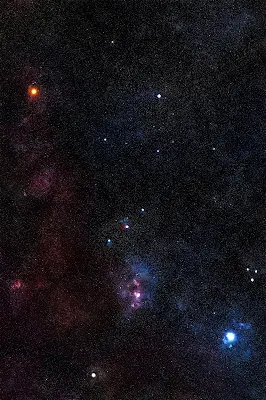Dark Matter
Matter that researchers cannot directly observe.

American astronomer Fritz Zwicky discovered in 1933 that the mass of all the stars in a cluster of galaxies in a coma provides only 1% of the mass needed to prevent galaxies from escaping the gravity of the cluster of galaxies. The remaining mass becomes a question for scientists. Astronomers Vera Ruby and Wkent Ford confirmed their existence by observing similar phenomena: the masses of stars are only 10% of the mass required to keep stars in orbit around the center of the galaxy.
Dark matter is the name for additional mass, the presence of which is determined only by gravitational attraction, but does not interact with light. It makes up about 25% of the energy density of the universe.
It is believed that dark matter is a massive particle (scale ~ 100 GeV), which practically does not interact, with the exception of gravity. There are several ongoing attempts to directly or indirectly detect suspected dark matter particles. According to the Standard Model, dark matter, as opposed to dark energy, makes up about 68% of the universe. Dark matter is invisible; it does not emit, reflect or absorb light or any electromagnetic radiation such as X-rays or radio waves.
Thus, dark matter cannot be detected directly, since all our observations of the Universe, except for detecting gravitational waves, involve receiving electromagnetic radiation through telescopes. However, dark matter interacts with ordinary matter and exhibits measurable gravitational effects on large structures. in the universe, for example, in galaxies and galaxy clusters. As a result, astronomers can map the distribution of dark matter in the universe, even if they cannot see it directly.
Reasons why people believe in dark matter.
Hot gas in X-rays: Huge clusters of galaxies contain hot diffuse gas (about the same mass as galaxies!) That glows in the X-ray range. This gas is also almost poisonous, and measurements by X-ray spectroscopy can lead to mass
Corresponding to gravitational lensing: according to general relativity, light deviates from its path in Newtonian gravity due to the presence of mass or energy. The statistics of deflection or distortion of multiple images around an object can be used to measure the total gravitational mass of a lens, regardless of the type of gravitational mass. This allows us to draw a map of the position of the mass and compare it with the position of the light source.
A famous example of this is the bullet cluster, which can be traced with visible light to determine the position of stars; X-rays to locate hot gas between galaxies; and lenses to determine where most of the mass is. X-ray gas is as massive or as massive as stars and has been separated from galaxies by a recent merger. More than you could see from the mass of X-ray gas plus stars) that have not yet collided and only occurred shortly after this merging event.
Internal energy of the mass at this radius: This method gives a mass about 10 times the visible mass of the luminous substance.
Scattering velocity mass of galaxies: If the galaxy clusters are assumed to be "virialized", which is a form of kinetic equilibrium, the velocity mass of the member galaxies can be determined. This gives a mass about 20 times the mass of the luminous substance of galaxies.
Cosmic microwave background: CMB analysis determines the extent to which matter agglomerates during scattering. There are several “sonic peaks” in the multipolar spectrum of the CMB, corresponding to the rare compression and influence of plasma on scales corresponding to the half-period of the age of the Universe at that time. Since normal matter supports pressure, but dark matter does not, this will affect compression in different ways.
Tuning the data required dark matter to fit the infrequent impact and compression model. effects before, but on the scale of the length of the present Universe, and not at the time of the final scattering.
Super symmetry suggests that a "lighter super symmetric particle" is needed, which could be an ideal candidate for the role of a dark matter particle.
Other suggestions are axion or any of the following lightest particles from any string theory model. The excluded models are MACHOs (mass compression halo objects) and neutrino dark matter (neutrinos would be too hot to be reassembled at appropriate scales).

